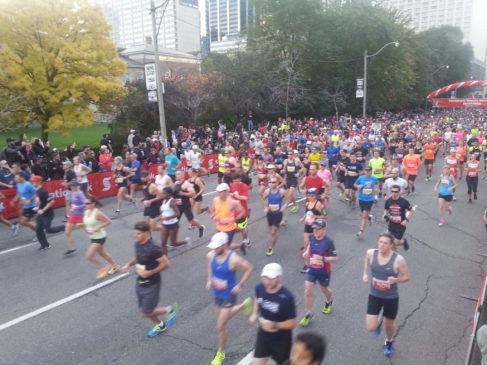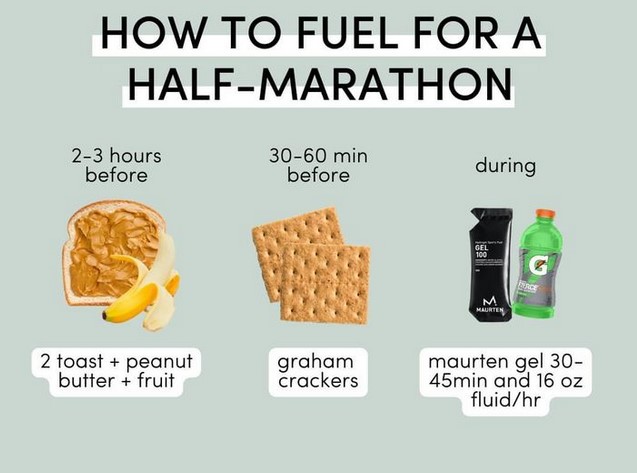How Long to Go from Not Running to a Marathon
To go from not running to a marathon, it typically takes several months of consistent training and preparation. The process involves gradually increasing your mileage, incorporating speed workouts and long runs, and allowing for proper rest and recovery.
Building endurance and strength is key to completing a marathon, so it’s essential to follow a training plan that suits your fitness level and goals. A gradual progression is necessary to prevent injury and ensure consistent improvement. By setting realistic expectations, staying committed, and following a structured training program, you can successfully go from not running to completing a marathon.
Keep reading to learn more about the steps involved in this transformative journey.
Assessing Your Starting Point
Begin by assessing your current level of fitness and running experience before setting a goal. Progressing from not running at all to completing a marathon will vary based on individual starting points, so understanding your baseline is essential. Take into consideration factors such as health, lifestyle, and commitment to create a tailored plan for your marathon journey.
Assessing Your Starting Point When it comes to training for a marathon, it’s crucial to understand your starting point before embarking on this challenging journey. Assessing your current physical fitness level and setting realistic goals are essential factors that will determine your success in transitioning from not running to completing a marathon. So, let’s dive into the process of evaluating your starting point and determining how long it might take you to go from being a non-runner to crossing that marathon finish line.Physical Fitness Evaluation
Before you begin training for a marathon, it’s important to assess your current physical fitness level. This evaluation will help you understand where you are starting from and what areas you need to focus on to improve your running ability. Here are some key aspects to consider during your physical fitness evaluation:- Cardiovascular Endurance: This refers to your body’s ability to sustain physical activity over an extended period. You can assess your cardiovascular endurance by timing how long you can maintain a moderate-intensity activity, such as jogging or brisk walking.
- Strength and Muscular Endurance: Running a marathon requires not only strong legs but also overall body strength. Evaluate your muscular endurance by performing exercises like push-ups, planks, and squats, and see how many repetitions you can comfortably complete.
- Flexibility: Flexibility plays a crucial role in preventing injuries and optimizing your running form. Assess your flexibility by performing basic stretches for your major muscle groups, such as hamstrings, quadriceps, and calves.
Setting Realistic Goals
Once you have assessed your physical fitness level, it’s time to set realistic goals that align with your current capabilities. Setting achievable objectives will not only prevent injury but also keep you motivated throughout your training journey. Here’s how you can set realistic goals when going from not running to a marathon:- Start with Short-Term Goals: Begin by setting short-term goals that are attainable within a few weeks or months. For example, aim to run a certain distance without stopping before progressing to longer distances.
- Gradually Increase Mileage: As a beginner, it’s essential to build your endurance slowly and incrementally. Gradually increase your weekly mileage by no more than 10% to avoid overuse injuries.
- Include Rest and Recovery: Adequate rest and recovery are crucial for preventing burnout and allowing your body to adapt to the demands of marathon training. Make sure to schedule rest days and incorporate activities like stretching, foam rolling, and low-impact cross-training into your routine.

Credit: coachcorkyruns.com
Building Up Your Endurance
Building up your endurance is a crucial step when training for a marathon. It’s not something that happens overnight, but with consistent effort and a smart training plan, you can gradually increase your stamina and go from not running to completing the 26.2-mile race. This article will explore two important aspects of building endurance for a marathon: starting with walking and jogging, and gradually increasing both distance and intensity.
Starting With Walking And Jogging
If you’re new to running or haven’t been active for a while, starting with walking and jogging is an excellent way to build up your endurance and prepare your body for the demands of marathon training. Walking is a low-impact exercise that allows you to gradually introduce your body to the movement and get your muscles and joints used to the workload.
Once you feel comfortable walking, you can slowly incorporate jogging intervals into your routine. Start with short bursts of jogging, for example, running for 30 seconds followed by walking for a minute. Repeat this pattern for a set number of intervals, gradually increasing the time you spend jogging and reducing the time you spend walking.
This gradual approach helps your body adapt to running and minimizes the risk of injuries. As you progress, you can increase the duration of your jogging intervals until you can comfortably run for several minutes without stopping.
Gradually Increasing Distance And Intensity
As you build up your endurance and become more comfortable with running, it’s time to focus on gradually increasing both distance and intensity. However, it’s crucial to do so in a strategic and safe manner to prevent overexertion and injuries.
When it comes to increasing distance, a general rule of thumb is to add no more than 10% to your weekly mileage. This means that if you’re currently running 10 miles per week, you should aim to add around 1 mile per week. This incremental approach allows your body to adapt and recover between runs, reducing the risk of overuse injuries.
In addition to increasing distance, you can also vary the intensity of your runs. Incorporate speed workouts, such as interval training or tempo runs, into your routine. These workouts challenge your cardiovascular system and improve your running efficiency. Start with shorter intervals or tempo runs at a comfortably hard pace, and gradually increase the duration and intensity over time.
Remember to listen to your body throughout this process. If you experience pain or excessive fatigue, it’s important to take a step back and allow for proper rest and recovery. Building up endurance takes time and patience, so don’t rush the process. Stay consistent with your training, follow a structured plan, and celebrate the small victories along the way.
Training Plan And Techniques
When it comes to transitioning from not running at all to training for a marathon, having a structured training plan and incorporating effective techniques is essential. This phase of the marathon journey is crucial for preventing injuries, building endurance, and improving overall performance. In this section, we will delve into how to create a structured training plan and the importance of incorporating strength and cross-training into your routine.
Creating A Structured Training Plan
A structured training plan is the foundation of successfully preparing for a marathon. It involves gradually increasing mileage, incorporating rest days, and specific workouts to improve stamina and speed. Consider consulting with a running coach or using reputable marathon training programs to tailor the plan to your fitness level and schedule.
- Gradually increase weekly mileage
- Include long runs and speed workouts
- Incorporate rest and recovery days
- Adjust according to individual fitness level and goals
Incorporating Strength And Cross-training
Strength training and cross-training are integral components of marathon preparation. They help to prevent overuse injuries, improve running efficiency, and enhance overall strength and flexibility. It’s essential to complement running with exercises that target different muscle groups and promote overall body balance.
- Include strength exercises such as squats, lunges, and core workouts
- Incorporate cross-training activities like swimming, cycling, or yoga
- Foster overall body strength, flexibility, and injury prevention
- Seek guidance from a fitness professional if needed

Credit: marathonhandbook.com
Nutrition And Recovery
Nourishing your body and allowing ample time for recovery are vital components of preparing for a marathon. Proper nutrition and effective rest and recovery practices play key roles in building endurance and reducing the risk of injury.
Fueling Your Body For Endurance
To sustain energy during long training sessions, it is crucial to prioritize nutrient-dense foods high in carbohydrates, proteins, and healthy fats. Maintaining hydration is also essential to optimize performance and aid in recovery.
Importance Of Rest And Recovery
Adequate rest is as important as training itself. Allow your body time to recover and repair muscle tissue after intense workouts. Incorporate stretching, foam rolling, and rest days into your training plan to prevent overtraining and promote muscular regeneration.
Mindset And Mental Preparation
Mindset and Mental Preparation: Developing a strong mindset and mental preparation is crucial when transitioning from not running to a marathon. It requires mental toughness and the ability to overcome various mental barriers.
Developing Mental Toughness
To develop mental toughness, focus on building resilience and perseverance through regular training sessions and positive self-talk.
- Engage in visualization exercises to mentally prepare for the challenges ahead.
- Set small, achievable goals to boost confidence and mental strength.
- Practice mindfulness techniques to stay present and focused during training.
Overcoming Mental Barriers
When facing mental barriers, it’s important to address them with a positive mindset and proactive strategies.
- Identify the root cause of the barrier and work on shifting your perspective towards it.
- Seek support from mentors or running communities to gain valuable insights and motivation.
- Practice mental resilience techniques such as deep breathing and positive affirmations.

Credit: www.nytimes.com
Frequently Asked Questions Of How Long To Go From Not Running To A Marathon
How Long Does It Take To Go From Non Runner To Marathon?
It varies for each individual, but with proper training, it typically takes around 6 to 12 months to go from being a non-runner to completing a marathon. Consistency, gradually increasing mileage, and following a training plan are key components for success.
How Long Does It Take To Go From Couch To Marathon?
It depends on the individual’s current fitness level and commitment, but typically, it takes about 4-6 months to go from couch to marathon. Regular training, gradually increasing running distance and intensity, and following a proper nutrition and recovery plan are crucial for success.
How Many Days Before A Marathon Do You Stop Running?
It’s recommended to stop running 3-5 days before a marathon to allow your body to rest and recover for the race. This helps prevent fatigue and muscle soreness on the race day.
Conclusion
Transitioning from not running to a marathon takes dedication, time, and perseverance. It’s important to listen to your body, gradually increase distance, and prioritize rest. Set realistic goals and celebrate milestones along the way. Remember, everyone’s journey is unique—be patient and stay committed to your training.
Good luck on your marathon journey!




